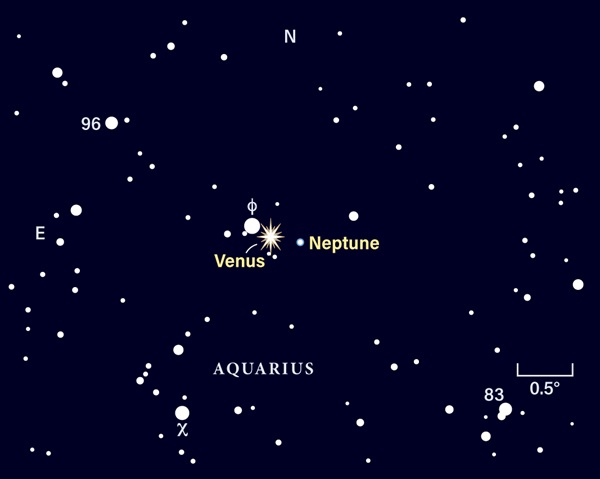The Sky This Week from January 24 to February 2 – Astronomy Magazine
A conjunction for the ages
The evening of January 27 finds Venus passing within a few arcminutes of distant Neptune in their closest approach since 1984.
Astronomy: Roen Kelly
Neptune proves even easier to find tonight, when it passes just 5′ north of Venus — the closest approach between these two planets since January 1984. The conjunction occurs at 2 p.m. EST, which places western Europe in the best viewing position. By the time night falls across North America a few hours later, Neptune lies 12′ west of Venus while Phi Aquarii stands a nearly equal distance to Venus’ east-northeast. Although 10×50 binoculars will separate the three objects, Neptune may be a challenge to see in Venus’ glare. A telescope shows the trio much more clearly. As if to draw attention to this extraordinary conjunction, a slender crescent Moon appears 7° below the two planets.
Tuesday, January 28
Uranus reached opposition and peak visibility three months ago today, but it remains a tempting target. The magnitude 5.8 planet appears nearly 60° above the southwestern horizon once darkness falls. The outer world lies in southwestern Aries the Ram, near that constellation’s border with Pisces the Fish and Cetus the Whale. Although Uranus shines brightly enough to glimpse with the naked eye from a dark site, binoculars will help your search immensely. The closest guide star is magnitude 4.4 Xi1 (ξ1) Ceti, which lies 4° to the southeast. A telescope reveals Uranus’ disk, which spans 3.5″ and shows a distinct blue-green hue.
Wednesday, January 29
Ruddy Mars grows more prominent before dawn with each passing week. The Red Planet now rises before 4 a.m. local time and climbs 20° above the southeastern horizon an hour before sunrise. Mars glows at magnitude 1.4 against the backdrop of Ophiuchus the Serpent-bearer, less than 10° east-northeast of its ancient rival, the 1st-magnitude star Antares in neighboring Scorpius. Unfortunately, a telescope doesn’t add much to our view of the planet, revealing a bland disk only 5″ across.
The Moon reaches apogee, the farthest point in its orbit around Earth, at 4:27 p.m. EST. It then lies 251,899 miles (405,393 kilometers) from Earth’s center.
Thursday, January 30
A pair of fine binocular objects are on display during the evening hours this week. The open star clusters M46 and M47 reside a degree apart in the northwestern corner of the constellation Puppis the Stern. The two lie about 12° east-northeast of the sky’s brightest star, Sirius. The western cluster, M47, glows at 4th magnitude and appears as a fuzzy patch sprinkled with several pinpoint stars. Sixth-magnitude M46 shows up as a hazy collection of faint stars that is hard to resolve under most conditions. Although it contains nearly twice as many stars as M47, M46 appears fainter and fuzzier because it lies some three times farther from Earth.






